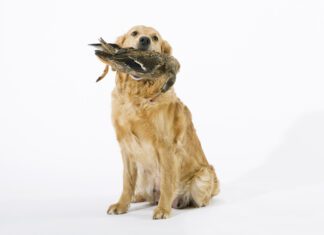Wet-Weather Coats and Care
As a mammalian physiologist, clothing designer, sled dog owner, and outdoorsman, I must disagree with your review of cold weather dog clothing (Coats for Chilly Dogs) in your October 1998 issue.
NONE of the coats you reviewed will keep an animal warm when they are wet. Polyester fleece is somewhat lighter per insulation value, and Thinsulate somewhat warmer per thickness, compared to traditional wool. But, when wet, all of these materials lose nearly all of their insulating value. (It helps in light rain that some of the Polarfleece now has a water-repellent treatment, sort of like the lanolin on the old Norse sweaters, but neither will work when you are really soaked and too exhausted to exercise to produce heat. )
And actually, if you have a dog with guard hair and underfur, like a Husky, adding an external layer in wet cold conditions will make the dog colder than if you left it alone. The outer layer will compress the natural insulation, reducing its effectiveness, and, if the dog gets soaked, will prevent it from drying itself by shaking off, lying in the sun, etc. If you want to warm a dog who lacks the Husky-type fur, there is really only one material worth looking at: nylon covered closed-cell neoprene foam, as used in SCUBA wetsuits.
I have seen ads for dog coats made of this material in hunting catalogs, and, if fitted snugly, they should work in most conditions, and also add a degree of floatation, which is useful if the dog is around water. And, since they do not absorb dirt, feces, urine, etc., as do woven fabrics, fleeces, etc., they can be easily cleaned up in the field.
Dogs metabolism is significantly different from humans, and when exposed to cold, they will acclimate and utilize non-shivering thermogenesis metabolic pathways in the liver. Some breeds bred for these conditions (Labs, etc.) utilize brown adipose tissue (BAT), burning more calories and thus increasing internal heat production. The single most effective means to protect dogs exposed to cold is to feed them more, preferably a medium protein (to reduce the need for water) and higher fat diet.
I have used bricks made of 22 percent protein commercial feed and fat by placing the feed in a non-stick cake tin, stirring in a mixture of fish oil and melted tallow, and letting it harden. Wrapped in butcher paper, the bricks keep in cold temperatures for quite a long time, stack easily for storage, and my dogs seem to do well on them, even for extended periods in low temperatures. Bring up the fat content slowly over several weeks in the fall, or expect a few days of loose stools until their digestive system gets used to the extra fat.
Hope this helps!
-Jack Sawicki and Snowshoe
(135 lb. F malamute)
Arlington, Virginia
I have to admit that as a California native, it never occurred to me to consider the clothing needs of dogs that are exposed to sub-zero temperatures when they were wet. We did say we werent including wet weather gear in our survey; however, we also said that our top pick in coats (the Polarfleece Snuggy made by Norman Equine Designs) would keep a dog warm even if wet. We appreciate the education.
Following up on your tip, we found the neoprene-style coat you referred to in two catalogs. Cabelas (800-237-4444) calls the coat a dog vest, and prices it at about $25. The product is intended for hunting dogs, so it is predictable that it is only available in safety orange, and camoflage green or brown. Dunns Supply Store (800-353-8621) sells a similar product for $30-40.
Editor
———-
WDJ Hits the Mark Again!
I am a dog trainer (and a member of the Association of Pet Dog Trainers) in Southern California. My business is called Canine Coach. I do in-home training and group classes, and have been a trainer for eight years. I just wanted to let you know that I thought the recent article on Vitamin C (Oh Say, Can You C? WDJ September 1998) was great. My nine-year old male Pomeranian eats Solid Gold, and gets both Seameal and The Missing Link. I will order some Sodium Ascorbate powder and see how it does.
I also enjoyed the article in the same issue about customizing your home to suit your dogs (In the Dog House). Im including a picture of my dog with his Doggie Doorbell. We had a square cut out of the bottom of the curtain to accommodate his dog door, but now that the dog doors gone (safety reasons) its a perfect spot for the Doggie Doorbell. The things we do to accommodate our dogs!
-Eugenia Williams
Torrance, CA
———-
Searching for Cartiflex
In the October issue, a letter to the editor mentioned a supplement called Cartiflex for arthritis. Where can I find it?
-Karen Thornton
via e-mail
Weve been able to find it in only one location: a catalog called Valley Vet Supply (800-360-4838). They offer the product in capsules, chewable tablets, and powder.
———-
Trustworthy Food?
In your review of canned foods (WDJs Top 10 Canned Foods, September 1998), you comment on Solid Gold: How did they manage to make canned food without added water for processing? We dont know, but . . .
Many years ago (probably more than 10) Equus magazine ran an article about how the FDA was trying to crack down on companies who were making unrealistic claims about their products. Solid Gold was one of the most flagrant abusers, claiming their products could cure just about everything. I believe they were one of the first companies to be prosecuted under a new labeling regulation and/or their violations helped lead to the new regulations.
A few years ago a friend was ordering their dry dog food. She got two bags of the same product one had a sticker placed over the ingredient panel with an updated (?) version of the ingredients, the other did not. Which ingredient panel do you believe? They both differed in one of the first three ingredients, the primary meat source.
This is just not a company that I would trust.
-Tracey Mini
Lynn, Mass
———-
Reader Recommends Food
When you reviewed the canned foods (September 1998), did you look at Evangers? Its made by Evangers Dog & Cat Food Company, Inc. of Wheeling, IL. Their Beef with chicken for dogs sells locally for 61 cents per 14-ounce can only a little more expensive than supermarket brands (Alpo, etc.). The ingredients are listed as Beef, whole dressed chicken, water sufficient for processing. Id appreciate any comments you may have on this or other Evangers products, as none of your top 10 are available here in High Point, North Carolina and all are much more expensive.
By the way, the pups on page 22 of the same issue do appear to have a little Border Collie in them. I recently acquired a new pup, Sparky, who has similar markings. His dam was a purebred Dalmatian and his sire was quick and in the night. He has the Border Collie markings, but the tail and eyes of an Akita.
Re: In the Dog House in the same issue. We have kept our pack at five dogs for some years now due to a local ordinance. We have a large fenced yard and a dog-door so the dogs can have easy access day or night. We have gates set up to keep the dogs out of the front room. The dogs have their own sofa and each has its own bed!
-Bill & Roxanne Hurd
High Point, NC





